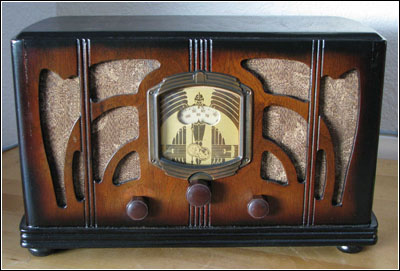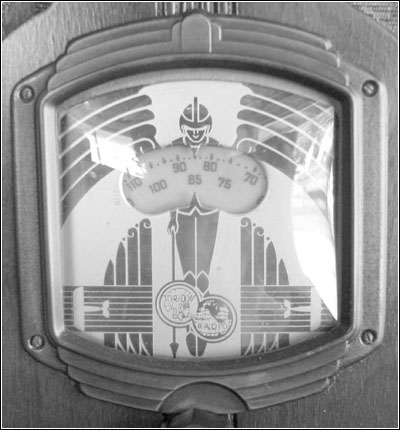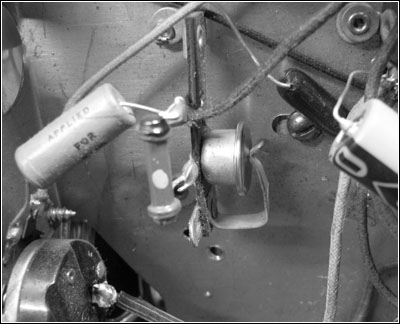Of Old Radios And Related Items--Published Monthly
The Upside of Moving
Rediscovering a Troy 75BY MIKE BIDDISON
Web Edition
Discovering a radio treasure can sometimes happen twice. Mike Biddison describes his lucky re-find as a result of another family move. (Editor)
After a lifetime habit of moving, I can readily say it ain't no picnic! But once in a while, as in this latest move from Southern California, an unexpected treasure turns up. In this case it was an artifact I didn't remember I had, so it was like finding it for the first time!
In the final stages of settling in to our new home, during a fit of unpacking several dozen paper wrapped objects, I came upon this unusual table radio, a 1936 Troy, manufactured in Los Angeles. See Figure 1. I can barely recall purchasing it, but I must have at some point in the past, and I could see why I did. Stylish arced lines in the grille gave it a "War of the Worlds" look that was reflected in the dial logo as well. Impressed into the metal plaque on the back of the chassis, was the model number 75, as shown in Figure 2 (see print version).
Figure 1. The Troy 75, ca 1936, with its stylish cabinet design and unusual dial.The As-Found Condition
The 5-tube layout was conventional with one notable exception, which I will get to. There were three knobs -- volume, tuning and a high-low tone switch. The cabinet had been refinished, albeit carelessly, exhibiting some obvious runs in the spray toning, and the toning color was a cordovan red, which did not quite match the walnut tinted veneer on the front of the cabinet.
In addition, the grille cloth had been replaced with something the restorer may have found in his wife's sewing box. It was an abstract brown and gold pattern that would look good on a couch or a large throw pillow. However, when used in small measure as a grille cloth, it was vaguely confusing.
Despite these defects, I was immediately in love with the Troy. Behind the glass-covered dial face loomed a figure that might be described as a spaceman from heaven! He had a Buck Rogers helmet and lines like wings radiating from his shoulders. In the middle of the figure, a lighted space shone with the dial positions, as shown in Figure 3. I have since learned from the Bunis Collectors Guide to Antique Radios that the design probably depicts a Trojan warrior carrying a spear, but I prefer to think of him as a man of the future, 1930s style.
It appeared that the radio's electronics had been somewhat casually restored in the not too distant past, and I did have to attend to certain overlooked details that affected its performance.
Restoration Details
First, I discovered that the speaker had been replaced with a permanent magnet, or dynamic type, not common in the 1930s. This speaker was buzzing, so I figured that since the original was not available, I would replace it with something that sounded good. I settled on a 4-ohm, 4-inch car audio speaker, with good bass response. See Figure 4 (see print version).
The previous restorer had installed a choke to replace the field coil of the original speaker, so no further circuit modifications were necessary. The audio improved immensely, but an annoying hum arose with the increased bass. The hum was still there with the volume down, a clear sign of filter cap problems.
The original filters had been replaced, so after a bit of head scratching, I looked to the schematic for answers. Turns out the previous casual restorer had placed one of the filters to ground instead of to the center tap of the power transformer, thereby effectively taking it out of the circuit. I made the simple adjustment, and the hum went away.
At this point a new problem arose. I noticed that when I turned up the volume, there was a howl, followed by lots of hum and distortion. It happened across the dial. I examined the barely legible schematic that I had downloaded off the internet for clues. Maybe a bad bias resistor. Aha! There was a thumb-sized battery cell on the grid of the Type 75 detector/audio tube, which obviously no longer provided voltage! This battery was the infamous Mallory bias cell. The 1930s acorn-sized battery had been used to provide bias to the first audio, something that I had not run across until recently in my dozen years of collecting.
Figure 3. The Troy dial face with its elaborate design, depicting what may be a Trojan warrior or perhaps a spaceman.Just two weeks before, I had visited Cliff Berthelsen at his radio warehouse in Merced, California, the city to which my family and I had just moved. Cliff, a member of the Central Valley Chapter of the California Historical Radio Society, claims he has a mere 150 or so radios as such, but the whole story is that there are thousands of radios and related items stuffed into that small warehouse.
Cliff can, after some deliberation, put his finger on everything in there. While I was visiting, he showed me a tray full of tiny bias cells and associated holders that came out of 1930s period radios. Cliff said the cells produced about 1.5 volts, and he showed how he rigged replacements.
Until that time, I had never seen one of these things, and now here they were. I inserted a AAA sized battery into the Troy circuit, and the sound immediately improved. Unfortunately, a AAA battery looked a bit out of place and would be difficult to hook up as well.
The answer to the dilemma was at my local RadioShack. There I found a lithium watch battery, just about the right size to fit into the battery holder with no modifications other than tweaking the spring to clamp onto the slimmer battery case. See Figure 5. It was a 3v but seemed to work as well as the 1.5v with only a slight reduction in volume. And because it was lithium, it would be five years before I had to replace it!
The Troy sounds good now, and looks OK, despite its na•ve finish and grille cloth. I think I will leave it alone for a while, displaying it in a prominent place, so I won't forget about it again.
Figure 5. The Troy chassis interior, showing the replacement 3v battery in original clip.References:
Bunis, Marty and Sue. Collectors Guide to Antique Radios, 3rd Edition. Paducah, KY: Collectors Books, 1995.
"Nostalgia Air." nostalgiaair.org.
Mike Biddison first came to love old radios in college in the 1960s while DXing with a World War II era Zenith console. He has since worked in commercial radio for 25 years, and embraced collecting as a hobby in 1994. He now repairs pro-audio and vacuum tube electronics in California.
|
[Free Sample] [Books, etc., For Sale] [Subscribe to A.R.C./Renew] [Classified Ads] [Auction Prices] [Event Calendar] [Links] [Home] [Issue Archives] [Book Reviews] [Subscription Information] [A.R.C. FAQ]URL = http://www.antiqueradio.com/Feb08_Biddison_Troy75.html Copyright © 1996-2008 by John V. Terrey - For personal use only. Last revised: February 1, 2008. For Customer Assistance please contact ARC@antiqueradio.com or call (866) 371-0512 toll free Pages designed/maintained by Wayward Fluffy Publications Antique Radio Classified |


